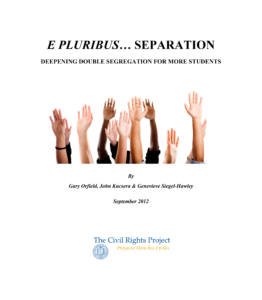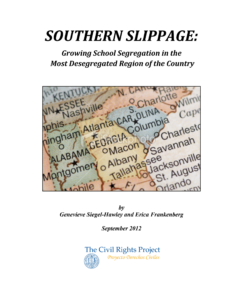Executive Summary
The U.S. Western region and its public schools are in the midst of its largest racial and economic transformation, as the area witnesses a shrinking white majority, a surging Latino minority, and a growing class of poor. These groups, along with blacks and Asian, more often than not attend very different and segregated schools both in educational opportunity and student body diversity. With its growing diversity potentially exemplifying our nation’s future demography, the West is an ideal region to determine how demographic transformation and segregation of our public schools can affect the rest of the nation if social and civil rights policy continue in their stagnant state.
According to data from the National Center for Education Statistics, as the proportion of white students drops and the percentage of Latinos rises, whites in the Western region are attending more diverse schools than whites across other regions. Yet, the interracial contact between white and Latino students is declining more than ever before, as more and more Latinos attend schools with 10% or fewer white classmates. To exacerbate this growing segregation, and without taking into account the full effect of the recent recession, two out of three students in a typical Latino student’s school are poor, often a clear indicator of an impoverished setting that lacks educational opportunities and morale often found in low poverty schools. A similar story emerges for black students in the West, as many attend impoverished schools with mostly Latino peers.
In the following report, we present an in-depth exploration of these Western trends that are merely summarized in the corresponding larger report, E Pluribus… Separated. Major findings in the West are highlighted below.
The Surge of Latinos and Asians
- The West is the most diverse region in the country. Latino students account for nearly the same share (39.9%) of the region’s enrollment as white students (41.9%).
- In 2009, both Asian and Latino students have nearly grown two-fold in regional proportionate size since 1980.
- New Mexico had the highest proportion of Latino students, followed by the state of California.
Deepening Segregation for Latino Students
- Concentration trends for Latino students became substantially more severe than for black students around 1991, likely reflecting both the massive growth of many Latino communities and the fact that most desegregation plans did not expressly include Latino students. The share of Latino students attending intensely segregated minority schools has increased steadily over the past four decades; presently, three out of four Latino students in the West attend schools with less than 10% of white classmates.
- Exposure to white students for the average Latino has decreased dramatically over the last four decades for every Western state. In Nevada, the average Latino attended school with 84% of white classmates in 1970, compared to 29% in 2009.
Decreasing Black Exposure to White Students
- Black exposure to white students has declined across the Western region over the last twenty years, while exposure to Latino students has steadily increased.
- The share of Black students attending majority-minority schools has increased since 1980; in 2009, nearly four out of five black students in the West attend schools with less than 50% of white classmates.
Double Segregation by Race and Poverty
- Though poverty has dramatically increased in the region since 1991, students of different racial backgrounds are not exposed equally to existing poverty. The typical Latino student, followed by black student, goes to a school with much higher concentrations of poor students than the typical white or Asian student.
- Across nearly all of the highest-enrolling metropolitan areas in the region, Latino students experience the highest levels of exposure to poverty. In the Los Angeles metropolitan area, the average Latino student attends a school where nearly 75% of students are poor, while the average white student attends a school where only about a fourth are poor.
Population change is fundamental
- The driving force behind increasing segregation in the West is the growth of the proportion of Latino students coupled with the continuing lack of desegregation plans. Twenty years ago, just before the Supreme Court began to roll back desegregation standards, 62% of Latino or white students in the West would have needed to attend schools with a greater proportion of the other racial group in order to achieve perfect integration. Today, that same percentage of students would have to do the same.
- At the metropolitan level, over half of the highest student-populated metros experienced higher white-Latino than white-black segregation, as measured by the dissimilarity index, a measure of the randomness of distribution of two populations among schools.
- Substantial Latino-white dissimilarity was found in the Los Angeles metro and surrounding area of Oxnard, as well as Salinas, CA. For example, 69% of Latino or white students in Los Angeles metropolitan area would need to attend schools with a greater proportion of the other racial group in order to achieve perfect integration in 2009.
With race and poverty at the center of educational inequality, these findings suggest that integration efforts are clearly needed for a region that is demographically transforming but resegregating, especially for the typical Latino student who will soon be the poster child of the West and the nation. As such, we offer several region-specific recommendations to reverse the trends presented in this brief, including the creation of comprehensible and transparent interdistrict and school-choice policies, support of high-quality magnet schools, and the enforcement of local housing policies, such as density regulations and inclusionary zones.
This research by the Civil Rights Project includes an extensive report on national trends, “E Pluribus… Separation: Deepening Double Segregation for More Students,” as well as two smaller regional reports: this one, “The Western States: Profound Diversity but Severe Segregation for Latino Students,” and “Southern Slippage: Growing School Segregation in the Most Desegregated Region of the Country.”
In compliance with the UC Open Access Policy, this report has been made available on eScholarship:



